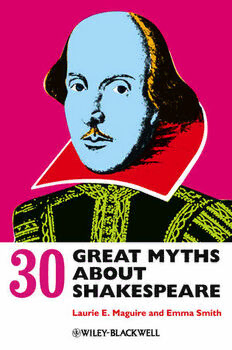
30 Great Myths about Shakespeare PDF
Preview 30 Great Myths about Shakespeare
30 GREAT MYTHS ABOUT SHAKESPEARE For Katherine Duncan-Jones 30 GREAT MYTHS ABOUT SHAKESPEARE Laurie Maguire Emma Smith A John Wiley & Sons, Ltd., Publication Thiseditionfirstpublished2013©2013JohnWiley&SonsLtd Wiley-BlackwellisanimprintofJohnWiley&Sons,formedbythemergerofWiley’s globalScientific,TechnicalandMedicalbusinesswithBlackwellPublishing. RegisteredOffice JohnWiley&SonsLtd,TheAtrium,SouthernGate,Chichester,WestSussex,PO19 8SQ,UK EditorialOffices 350MainStreet,Malden,MA02148-5020,USA 9600GarsingtonRoad,Oxford,OX42DQ,UK TheAtrium,SouthernGate,Chichester,WestSussex,PO198SQ,UK Fordetailsofourglobaleditorialoffices,forcustomerservices,andforinformationabout howtoapplyforpermissiontoreusethecopyrightmaterialinthisbookpleaseseeour websiteatwww.wiley.com/wiley-blackwell. TherightofLaurieMaguireandEmmaSmithtobeidentifiedastheauthorsofthiswork hasbeenassertedinaccordancewiththeUKCopyright,DesignsandPatentsAct1988. Allrightsreserved.Nopartofthispublicationmaybereproduced,storedinaretrieval system,ortransmitted,inanyformorbyanymeans,electronic,mechanical, photocopying,recordingorotherwise,exceptaspermittedbytheUKCopyright,Designs andPatentsAct1988,withoutthepriorpermissionofthepublisher. Wileyalsopublishesitsbooksinavarietyofelectronicformats.Somecontentthatappears inprintmaynotbeavailableinelectronicbooks. Designationsusedbycompaniestodistinguishtheirproductsareoftenclaimedas trademarks.Allbrandnamesandproductnamesusedinthisbookaretradenames,service marks,trademarksorregisteredtrademarksoftheirrespectiveowners.Thepublisheris notassociatedwithanyproductorvendormentionedinthisbook.Thispublicationis designedtoprovideaccurateandauthoritativeinformationinregardtothesubjectmatter covered.Itissoldontheunderstandingthatthepublisherisnotengagedinrendering professionalservices.Ifprofessionaladviceorotherexpertassistanceisrequired,the servicesofacompetentprofessionalshouldbesought. LibraryofCongressCataloging-in-PublicationData Maguire,LaurieE. 30greatmythsaboutShakespeare/LaurieMaguireandEmmaSmith. p.cm. Includesbibliographicalreferencesandindex. ISBN978-0-470-65850-5(hardback:alk.paper)–ISBN978-0-470-65851-2(pbk.:alk. paper) 1.Shakespeare,William,1564-1616–Criticismandinterpretation.I.Smith,Emma (EmmaJosephine)II.Title.III.Title:ThirtygreatmythsaboutShakespeare. PR2976.M362013 822.3(cid:2)3–dc23 2012026659 AcataloguerecordforthisbookisavailablefromtheBritishLibrary. Setin10/12ptSabonbyLaserwordsPrivateLimited,Chennai,India 12013 CONTENTS Introduction 1 Myth1 Shakespearewasthemostpopularwriterofhistime 6 Myth2 Shakespearewasnotwelleducated 11 Myth3 Shakespeare’splaysshouldbeperformedin Elizabethandress 18 Myth4 Shakespearewasnotinterestedinhavinghisplays printed 26 Myth5 Shakespearenevertraveled 34 Myth6 Shakespeare’splaysarepoliticallyincorrect 40 Myth7 ShakespearewasaCatholic 47 Myth8 Shakespeare’splayshadnoscenery 54 Myth9 Shakespeare’stragediesaremoreseriousthanhis comedies 60 Myth10 Shakespearehatedhiswife 66 Myth11 Shakespearewroteintherhythmsofeveryday speech 72 Myth12 HamletwasnamedafterShakespeare’sson 80 Myth13 ThecoarsebitsofShakespeareareforthe groundlings;thephilosophyisfortheupperclasses 86 Myth14 ShakespearewasaStratfordplaywright 94 Myth15 Shakespearewasaplagiarist 99 vi Contents Myth16 Wedon’tknowmuchaboutShakespeare’slife 106 Myth17 Shakespearewrotealone 113 Myth18 Shakespeare’ssonnetsareautobiographical 119 Myth19 IfShakespearewerewritingnow,he’dbewritingfor Hollywood 125 Myth20 TheTempest wasShakespeare’sfarewelltothestage 130 Myth21 Shakespearehadahugevocabulary 137 Myth22 Shakespeare’splaysaretimeless 143 Myth23 Macbethisjinxedinthetheater 150 Myth24 Shakespearedidnotrevisehisplays 156 Myth25 Boyactorsplayedwomen’sroles 163 Myth26 Shakespeare’splaysdon’tworkasmovies 169 Myth27 Yorick’sskullwasreal 175 Myth28 QueenElizabethlovedShakespeare’splays 183 Myth29 Shakespeare’scharactersarelikerealpeople 190 Myth30 Shakespearedidn’twriteShakespeare 196 Coda 202 FurtherReading 207 Index 211 ThismemorialmonumentinthegardenofthechurchofSt.MarytheVirgin, Aldermanbury,London,isactuallyadoubletribute.Itcommemorates Shakespeareandthetwoeditorswhocollectedhisplaysintheposthumous memorialvolumeofComedies,Histories,&Tragedies(1623). Photo:Col.PeterJ.DurrantMBE. INTRODUCTION This book attempts to interrogate the things we think we know about Shakespeare, and we have called this body of knowledge ‘‘myths.’’ Why ‘‘myths’’? We were drawn to this term for the Shakespeare content in eachofourchaptersbecause‘‘myth’’foregroundstheactofstorytelling; because it underlines the cultural work these stories do rather than their accuracy; because it is not about a specific point of origin but about accepted beliefs; because it is about the people who accept or invent or need these stories as much as it is about the stories themselves. Not all of our myths are untrue: in calling these beliefs ‘‘myths’’ we are less interestedinstigmatizingthemasfoolishorunsubstantiatedthanweare concernedtounderstandhowtheybecomeossifiedandblock,ratherthan enable,ourinterpretationofShakespeare’sworks. Karen Armstrong’s A Short History of Myth (2005) offers some pithy observations. Myths are dynamic: they change over time, they adapt themselves to cultural and historical developments, they have accretions anddeletions,theyironout–oraccumulate–contradictions.Mythsare not historically accurate: they do not work by being factual; they are interested in what an event meant, not in what actually happened; they are designed to be effective, not true. Myths provide explanations for somethingwemightnototherwisebeabletomakesenseof;theygiveus comfort.Mythsservedifferentpurposesatdifferenttimes,beingfactored intoaculture’snationalorreligiousorpoliticalhistory.And,sheargues, humans are myth-seeking creatures.1 That is to say, we are creatures drawntostories.Myth,fromtheGreekmuthos,meanssomethingthatis told, a speech, a narrative, a fiction, a plot. From here it comes to mean asetofbeliefs(personalorcollective). 30GreatMythsAboutShakespeare,FirstEdition.LaurieMaguireandEmmaSmith. ©2013JohnWiley&Sons,Ltd.Published2013byJohnWiley&Sons,Ltd. 2 Introduction MythsaboundaboutShakespeareinpartbecauseofhalf-remembered orout-of-datescholarshipfromschooldays,becauseShakespearetheman is such an elusive and charismatic cultural property, and because inter- ventions in Shakespeare studies, particularly biographical and theatrical ones,makeheadlinenews:witnessthe‘‘authorshipquestion’’(Myth30) orspeculationaboutShakespeare’sbeliefsorsexuality(Myths7and18). Put simply, myths are told and retold about Shakespeare because no other writer matters as much to the world: nineteenth-century Germany had a flourishing academic Shakespeare criticism before England did; IndiahadaShakespeareSocietybeforeEngland;Shakespeareisregularly performedatamateurandprofessionallevels,intranslation,worldwide. ShakespeareisnotjustEnglish(asGermany’s‘‘unser[our]Shakespeare’’ attests). Thus myths about Shakespeare go some way toward telling us storiesaboutourselves. As Armstrong details, myths can be fictional and erroneous–and many, but not all, of these Shakespeare myths are–but more often they turn out, in important and revealing ways, to follow two related definitionsoftheword‘‘myth’’fromtheOxfordEnglishDictionary.The firstis Atraditionalstory,typicallyinvolvingsupernaturalbeingsorforces,which embodiesandprovidesanexplanation,aetiology,orjustificationforsome- thing such as the early history of a society, a religious belief or ritual, or a naturalphenomenon. WhileShakespeareisnotquitea‘‘supernatural’’being,manyofthemyths wediscussexplainorjustifywidelyheld,oftenunexamined,beliefsabout art, authorship, and cultural value. The second relevant definition of myth is ‘‘a popular conception of a person or thing which exaggerates or idealizes the truth.’’ Many of our myths are just that: popular, often reiteratedideaswhichmayhaveabasisinfact,butwhichover-emphasize the available evidence or speculate to fill in gaps in the documentary record.OftenthehonestanswertoourquestionsaboutShakespearehas to be that we are unsure: in place of that uncertainty, myths provide comforting and positive ‘‘truths’’ about the subject. In this book we try to peel our collective fingers from this comfort blanket, even though sometimes the unsettling outcome is that we know less than we thought wedid. Thisbookarosefromourinterestinarelatedbookinadifferentfield: Fifty Great Myths of Popular Psychology (2009). The book includes such familiar propositions as: opposites attract; we use only 10 percent of our brain power; playing Mozart to babies boosts their intelligence; it’s better to express anger than to hold it in. These are myths that have Introduction 3 becometraditionaltruths;infact,theyhaveattainedproverbialstatus,as theepigrammaticchapterheadingsshow.Thebook’ssubtitle,Shattering Widespread Misconceptions about Human Behavior, indicates its pur- pose: it is a demythologizing book. The authors explain: ‘‘In this book, we’llhelpyoutodistinguishfactfromfictioninpopularpsychology,and provideyouwithasetofmyth-bustingskillsforevaluatingpsychological claims scientifically.’’2 What, we wondered, were the equivalent myths thatpopulatepopularunderstandingofShakespeare? Abookexploringthisquestionalreadyexists:StanleyWells’IsitTrue What They Say about Shakespeare?3 Wells’ encyclopedic Shakespeare knowledge is here put to the service of eighty-nine myths about Shake- speare’s life and authorship. He considers whether Shakespeare ‘‘had a shotgun wedding,’’ ‘‘was gay,’’ ‘‘died of syphilis,’’ ‘‘wrote a play called Cardenio,’’ ‘‘portrayed himself as Prospero,’’ or ‘‘uses an exceptionally largevocabulary.’’LikeFiftyGreatMythsofPopularPsychology,Wells’ isamyth-bustingbook.Wellsinterrogatesthecategorieswithinvigorat- ingbriskness,andendseachchapterwithaverdict:‘‘unlikely,’’‘‘maybe,’’ ‘‘I remain sceptical.’’ Although we investigate many of the same cate- gories as Wells, it is not because we disagree with his conclusions but because we are interested in different things. When we consider the question of whether ‘‘Shakespeare was the most popular writer of his day,’’forinstance,weareinterestedinthedauntingquestionofhowone would even begin to evaluate such a proposition, where one might go for evidence to support or refute it, in fact, what constitutes ‘‘evidence’’ (print runs? reprints? references to Shakespeare? audience attendance?); wearenotinterestedinreachingaYesorNoconclusion. Thenumberofessaysinthisbook–thirtytotheeighty-nineofWells’ bookorthefiftyofthePsychologybook–illustratesourdifferentfocus. ManyofWells’mythsaresummarizedinoneparagraphor,memorably, even one sentence. We have given ourselves 2,000–2,500 words for each of our myths. It is no coincidence that this is the length of the standard undergraduate essay (or newspaper article). As academics we are accustomed to writing in chapter-chunks of 8,000-12,000 words. Hereweareinterestedinseeingjusthowmuchonecandointheshorter essay format, how much information a 2,000-word essay can develop, howmanyturnsofanargumentitcanmake;inshort,howitcanpursue evidencewithoutgettingtooboggeddownindetail.Wehavelearnedalot fromthisexercise;anditisourhopethatstudentsmaylearnfromreading ourexamplesoftheformatinwhichtheyconductalltheirarguments. Thisisnottosaythatwehavewrittenthisasacompositiontextbook. We hope, equally, that the general Shakespeare reader and lover will find much of interest in the material we cover, and will find a path from well-known and often-repeated ideas into plays, approaches, and
